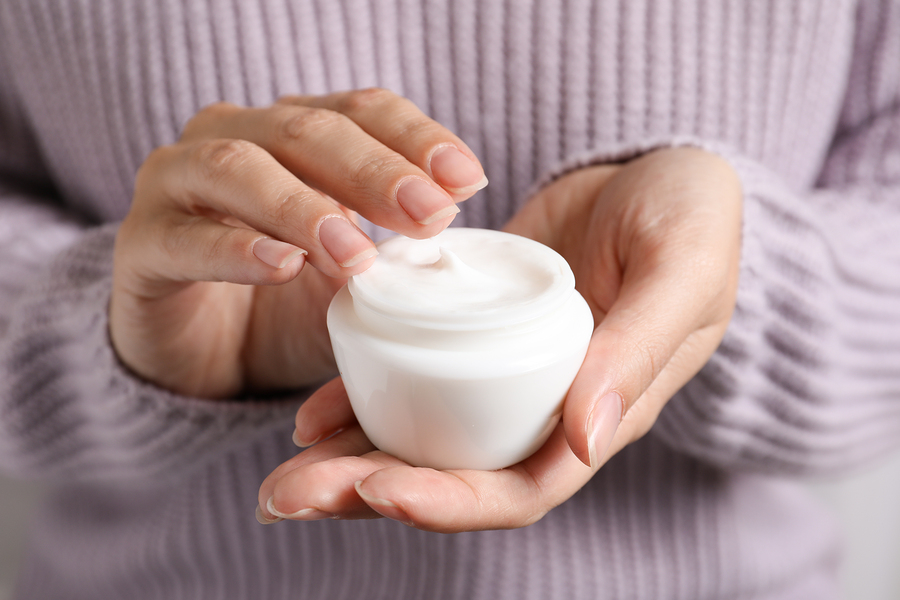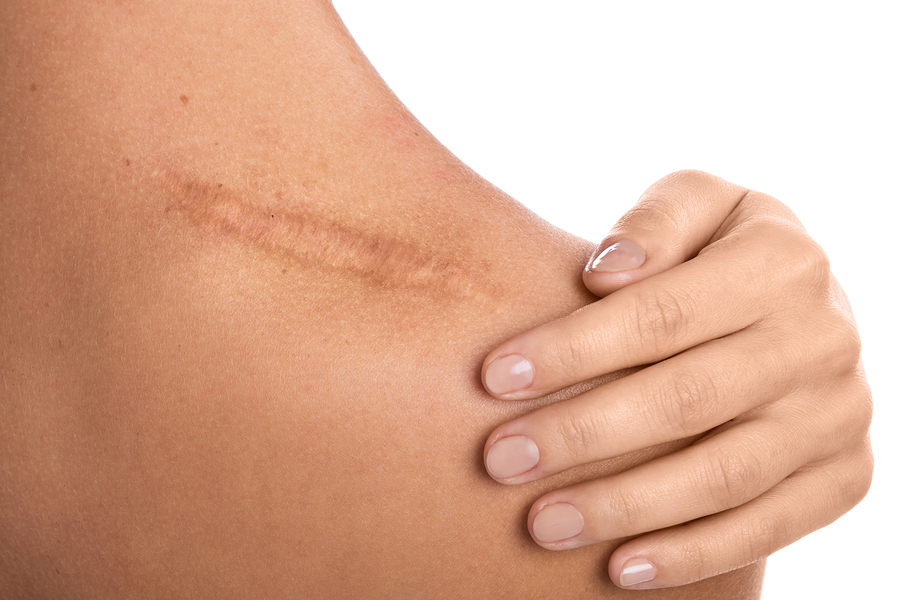Understanding and treating scars
Here we look at ways to understand, treat and reduce scars
If you’ve recently suffered a cut or had an operation, your body should be starting the process of healing. Here the Health at Hand team help us to understand how our skin heals, the different types of resulting scars and how best to treat and reduce them
The best way to wash a scar is with a moisturising type of soap or gel as ideally, the skin should not become too dry. After washing and drying then massage the scar with a fragrance-free moisturising cream or ointment. This will need to be applied every day for several months and sometimes longer. If your scar is particularly stubborn then you might consider applying a silicone-based gel or sheet.
It is also important to protect the scar from the sun and keeping it covered for a good year or so is the best way to do this. If you can’t cover your scar then use a sun cream of SPF35 or more.
If your scar becomes hot or painful then it could be a sign that infection has set in – you should then make sure it’s checked out by your medical practitioner. If your scar is itchy then taking antihistamine tablets may help and may stop the impulse to scratch which in turn will help stop infection.
How the skin repairs itself
Almost immediately after there is a cut in the skin a scab starts to form and acts as a barrier against infection. Once the scab is in place the wound starts to heal from the inner layers to the upper layers of the skin.
There are 3 stages of healing:
First stage – initial inflammatory
This stage is your body’s natural response and is where the contraction of the blood vessels forms a clot. As soon as the bleeding has stopped the area is flooded with white blood vessels, antibodies and other essential nutrients.
Second stage – proliferation
Granular tissue (with collagen) then increases to form new skin. A good source of oxygen and nutrients are vital at this stage for healthy granulation tissue. The wound is now typically uneven; pink in colour and less likely to bleed. The appearance of the wound now determines how well it is healing.
Third stage – maturation or remodelling
This is the final stage of healing. Some of the collagen will disappear so the scar will now appear flatter and softer. This final stage can sometimes last up to 18 months.
Ideally, a wound should heal from the deeper layers upwards but if healing starts from the top first this can result in it breaking open again. A wound, therefore, needs care and time to heal properly.
The definition of a scar
A scar is a mark left on the skin (or within the body tissue) where fibrous tissue has replaced normal skin after a wound has healed. Scarring is a natural part of the healing process. A scar will look red at first but this will fade and it will begin to look more like normal skin, although this can take up to 2 years of massaging and moisturising.
There are typically two different types of scar: the hypertrophic scar and the keloid scar.
A hypertrophic scar usually occurs when the dermis (the deeper layer of skin) is damaged. This is as a result of excess amounts of collagen being made during the body’s healing process.
A typical hypertrophic scar first appears 3 weeks after surgery or an injury has occurred and presents as red, raised and thick. It can also be itchy. After 2 years it should look much more like normal skin. It does not usually spread any further than the original wound.
A keloid scar is more likely to spread outside the boundary of the original wound and can develop from 3 to 12 months after the original injury. It can stay raised and is generally hard, shiny, and hairless. It can be red or purple in colour possibly getting paler or darker over time. Generally painless at first, it can become more tender or itchy.
What can help to reduce scars?
One of the best ways to prevent or reduce the appearance of a scar is to moisturise the area once the wound has healed (generally around 3 weeks). Using bath emollients or moisturisers will help.
How effective are emollients?
Normal soap can leave the skin dry but emollients will soothe, hydrate and make the skin smooth. Emollients can be used in the form of a bath oil or shower gel. Emollients are effective but short-lived so, in addition, it is recommended to apply a moisturising cream or ointment on the area to give more lasting results.
Some emollients to try are:
Aveeno bath oil
Balneum bath oil
Doublebase emollient bath additive or shower gel,
E45 bath oil or E45 wash cream,
Oilatum emollient bath additive or shower gel
QV bath oil and QV gentle wash or
Zeroneum

Moisturising cream
When to use moisturisers
It is best to use a moisturiser after the skin is washed and dried thoroughly. They are effective as they allow the skin to hold onto moisture longer.
Moisturisers come as either a cream or an ointment. Ointments are generally oil based and will stay longer on the skin but can give an oily feel. Creams are water based and are absorbed easily into the skin but will not stay as long as an ointment.
Try the following for use on small scars:
- Aveeno cream
- Diprobase cream or ointment
- Doublebase cream or ointment
- Epaderm ointment
- E45 cream
- Hydromol ointment
- Oilatum cream
What about silicone gel?
Silicone-based products have proved to be effective on deeper hypertrophic and keloid scars. They aim to decrease the elevation of the scar and reduce pigmentation.
Silicone gel should be massaged into the scar for approximately 10 minutes up to 3 times a day and should be continued for several months to help clear the scar tissue.
If the skin is exposed to sunlight then cream with a factor of 35 or greater should be used.
Some silicone gels to try are:
- Bapscarcare
- Ciltech
- Dermatix
- Kelo-Cote UV, gel or spray
- NewGel+E
- ScarSil
- Silgel STC-SE
How does it help to massage the scar?
Gently massaging the scar will help the skin to become more soft and supple and enable it to regain a normal range of elasticity and movement. Massage should be started around 3 weeks after the wound has started to heal and should always be gentle; if it is painful then the wound may not be healed enough or may be infected.
Using silicone sheets
Silicone-based sheets are easy, convenient and may be another option to consider. One sheet should be applied to the scar for between 12 and 23 hours each day.
Silicone sheets to try are:
- Advasil Conform
- Bapscarcare T
- Cica-Care
- Ciltech
- Dermatix
- Mepiform
- Scar FX and Silgel
Why take an antihistamine?
Antihistamine helps to stop itching which may help to prevent infection. If there is no pain and the wound is not hot or throbbing then an antihistamine tablet or capsule is safe to use.
Some commonly bought antihistamine tablets:
- Piriton (chlorphenamine) 2mg tablets – you can take up to 3 tablets in 24 hours but it can make you drowsy so you should not drive or operate machinery whilst it is in your system
- Cetirizine and loratadine – take 1 tablet within a 24 hour period, non-drowsy antihistamine
- Acrivastine – can be taken up to 3 times a day (8 hours between tablets) and works within 15 minutes. Non-drowsy but expensive to purchase and not recommended for over 65 ‘s.
Be safe
It is important to rule out infection, eczema or any other underlying condition before starting to use the above suggested products so it is recommended to see your GP first.
A steroid cream may be prescribed to aid recovery too.
To read more about how to manage your scar visit Scar Management – NBT
Managing your scar – Moffitt or Keloid Scarring – NHS
Disclaimer
All content on Silversurfers.com is provided for general information only, and should not be treated at all as a substitute for the medical advice of your own doctor or any other health care professional. Silversurfers will not be responsible or liable for any diagnosis made by a user based on the content on www.silversurfers.com and we are also not liable for the content of any external websites or links from or to Silversurfers to any other websites. Please always consult your own doctor if you’re in any way concerned about any aspect of your health
Melina - Assistant Editor
Latest posts by Melina - Assistant Editor (see all)
- Banana bread with SunGold kiwis - February 20, 2025
- A tribute to Bob Marley - February 4, 2025
- Going to Work on an Egg! - January 29, 2025
- The Very Best of Petula Clark - January 14, 2025
- 50 Years of Coat Trends - January 12, 2025




















